If you're curious about the worst cities for sex trafficking, Houston, TX, tops the list with over 1,021 cases reported from 2007 to 2016. Los Angeles follows closely behind with 884 cases, fueled by its large population. New York ranks third with 759 cases, while Washington, D.C., and Chicago report 596 and 507 cases, respectively. Economic disparities, a significant immigrant population, and urban anonymity contribute to these alarming statistics. It's vital to educate yourself about this pressing issue. Keep exploring to uncover more about how these cities are battling trafficking and the efforts being made to help victims.
Key Takeaways
- Houston, TX, leads with over 1,021 reported human trafficking cases from 2007 to 2016, marking it as a significant trafficking hotspot.
- Los Angeles, CA, follows with 884 cases, driven by high population density and economic disparities.
- New York, NY, reports 759 trafficking cases, influenced by its diverse population and socioeconomic challenges.
- Washington, D.C., has 596 cases, largely impacted by economic inequality and its urban environment.
- Chicago, IL, with 507 reported cases, continues to face challenges in effectively combating sex trafficking.
Overview of Sex Trafficking
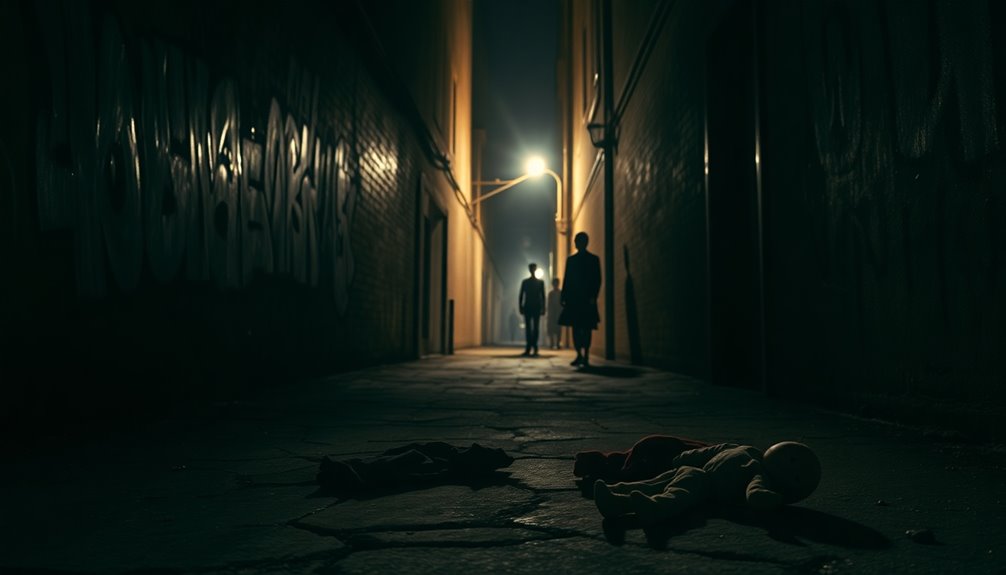
Sex trafficking, which you may not often think about, is a devastating form of modern-day slavery that exploits vulnerable individuals for commercial sex acts.
With an estimated 4.8 million people caught in forced sexual exploitation globally, this issue is alarmingly prevalent. The average age for entry into sex trafficking is between 12 and 14 years, highlighting how easily children become targets.
In cities like Houston, Texas, the statistics are staggering, with 313,000 victims trafficked statewide.
Victims endure severe long-term psychological effects, including post-traumatic stress disorder (PTSD), stemming from their traumatic experiences.
Despite growing awareness, many cases remain unreported, emphasizing the urgent need for intervention and support to protect these vulnerable individuals and address the complex realities of sex trafficking.
Major Contributing Factors

While various factors contribute to the alarming rates of sex trafficking in major cities, economic disparities stand out as a significant catalyst. High poverty rates create vulnerable populations that traffickers exploit for commercial sex acts.
Additionally, the presence of significant immigrant populations often exacerbates the issue. Many immigrants lack awareness of their rights and available resources, making them prime targets for traffickers.
Urban environments further facilitate trafficking due to anonymity, allowing traffickers to operate with less detection. Proximity to international borders, as seen in cities like San Diego, heightens the risk of exploitation.
Ultimately, a lack of awareness and education about human trafficking prevents communities from recognizing the signs, leaving them susceptible to this heinous crime.
Impact on Victims
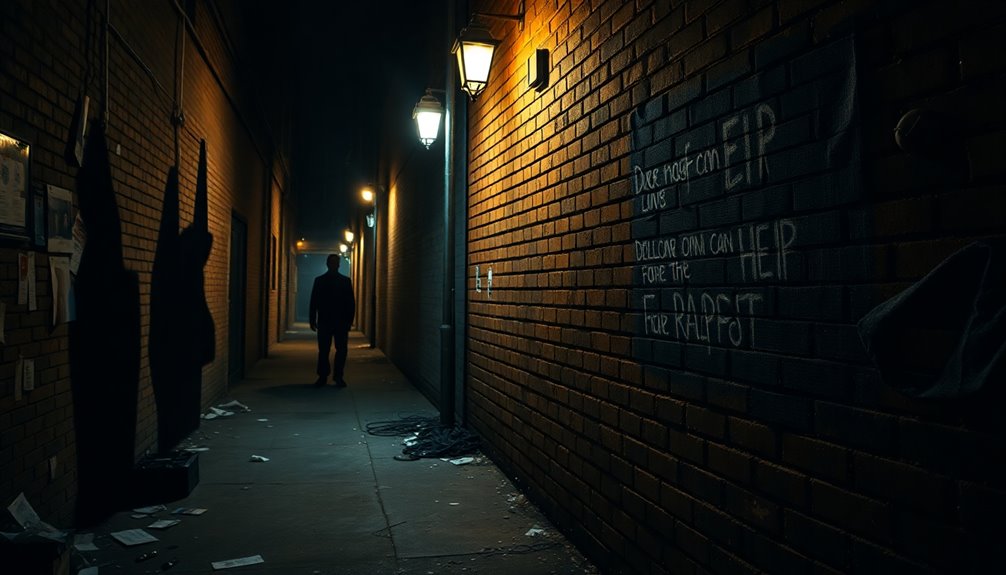
The impact on victims of trafficking is profound and often devastating, as they endure not only physical abuse but also deep psychological scars. Many victims enter the horrific world of sex trafficking between the ages of 12 and 14, leading to long-lasting mental and emotional issues.
Human trafficking statistics reveal that survivors frequently develop PTSD, anxiety, and depression, exacerbated by the physical violence and sexual abuse they face. Economic abuse strips them of financial independence, making reintegration into society even tougher.
Additionally, stigma and fear of law enforcement significantly hinder their access to support services. The impact on victims is a cycle of trauma, preventing them from reclaiming their lives and achieving healing.
Top Ten Worst Cities
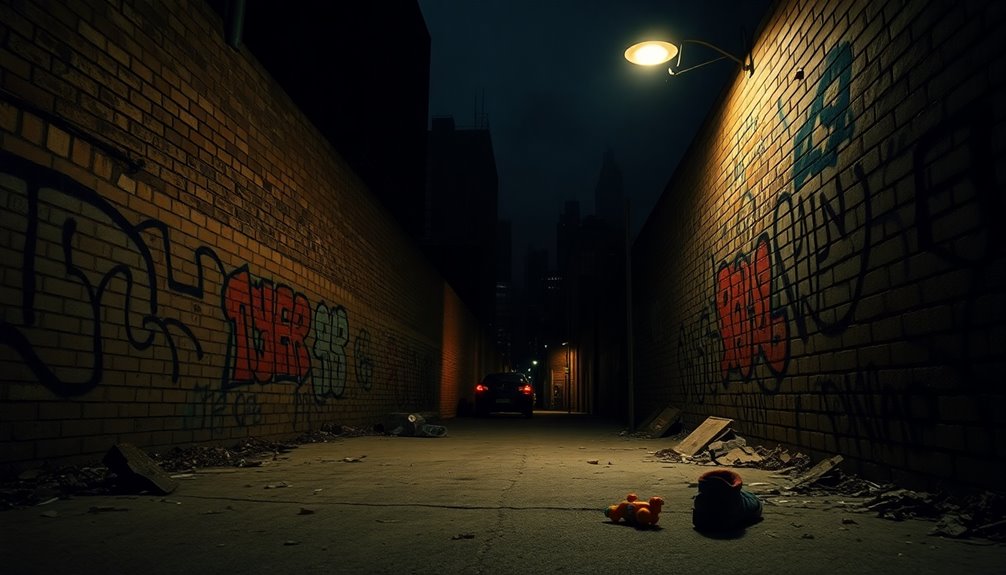
Identifying the top ten worst cities for sex trafficking reveals a troubling landscape of exploitation across the United States.
Houston, TX, tops the list with over 1,021 human trafficking cases reported between 2007 and 2016, highlighting its critical situation.
Following closely is Los Angeles, CA, with 884 cases, a reflection of its high population density and economic disparities.
New York, NY, ranks third, reporting 759 cases, driven by its diverse population that increases vulnerability to exploitation.
Washington, D.C., sees 596 reported cases, fueled by economic inequality and a transient population.
Chicago, IL, with 507 cases, underscores ongoing challenges in combating sex trafficking.
These cities share a stark reality that demands urgent attention and action.
Statistics and Trends
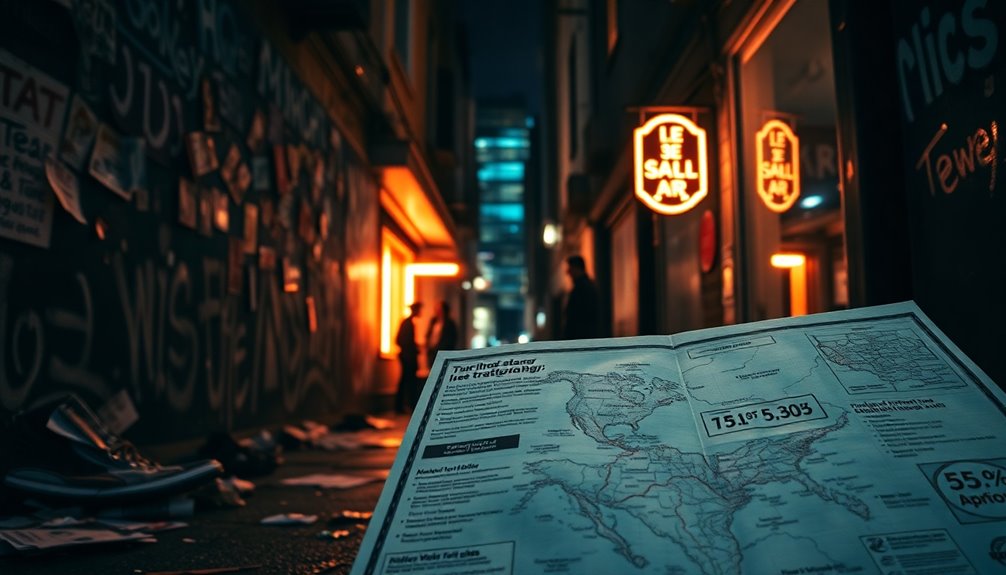
As you delve into the statistics and trends surrounding sex trafficking, you'll find a stark increase in reported cases across major U.S. cities.
Houston, TX, stands out with over 1,021 cases reported from 2007 to 2016, making it the top city for sex trafficking incidents.
Los Angeles follows closely with 884 cases, showcasing significant challenges in combating human trafficking.
New York also ranks high with 759 cases, influenced by its diverse population and economic disparities.
Washington D.C. reflects ongoing issues with 596 cases, despite numerous awareness campaigns.
Lastly, Chicago reports 507 cases, highlighting persistent problems with sex trafficking and child prostitution.
These statistics reveal a troubling trend that demands urgent attention and action.
Law Enforcement Challenges

While law enforcement strives to combat sex trafficking, they face significant hurdles that hinder their effectiveness. One major challenge is identifying victims, as the hidden nature of trafficking makes gathering accurate data tough. Many officers lack specialized training, which limits their ability to spot signs of trafficking and respond appropriately.
Additionally, victims often fear law enforcement due to previous negative encounters, leading to underreporting of cases. Resource constraints, including limited funding and personnel, further complicate investigations in trafficking cities.
Jurisdictional issues arise when trafficking crosses state or international borders, requiring collaboration among multiple agencies. These law enforcement challenges create a complex environment, allowing human traffickers to exploit weaknesses in the system and persist in their criminal activities.
Community Awareness Initiatives
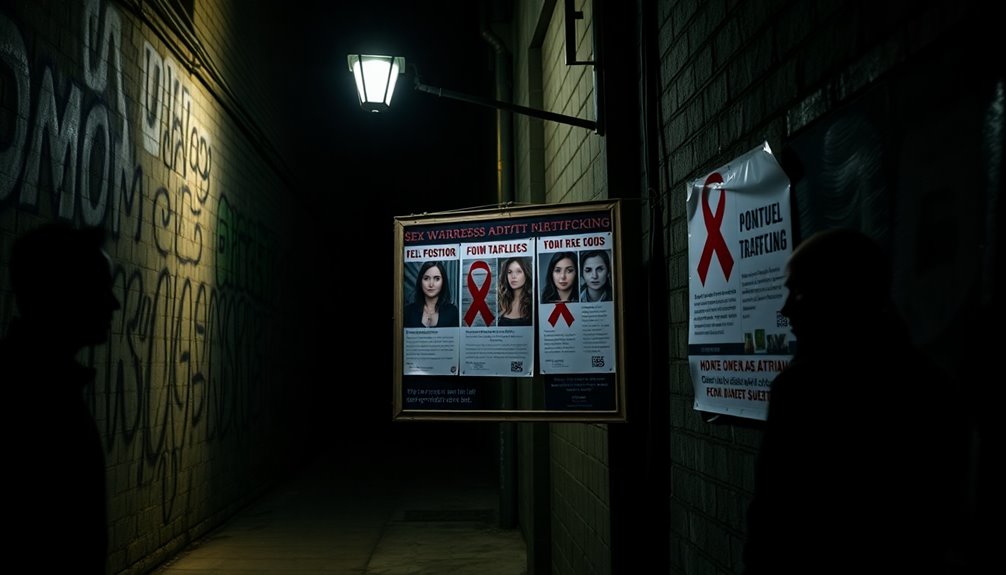
Addressing the challenges faced by law enforcement in combating sex trafficking requires a concerted effort from the community.
Community awareness initiatives are vital in educating you about the signs of sex trafficking, particularly in major cities like Houston, Los Angeles, and New York City. Workshops and training programs empower you to recognize red flags, while social media campaigns effectively spread awareness and engage residents.
Collaboration between local initiatives and law enforcement enhances resources for survivors, fostering resilience in cities like Atlanta. By advocating for dialogue and mobilizing action, you contribute to greater awareness and prevention of sex trafficking in vulnerable neighborhoods.
Your involvement is essential in creating safer communities and combating this pressing issue.
Resources for Victims

Thousands of victims of sex trafficking find themselves trapped and in desperate need of help.
Fortunately, there are vital resources for victims available. You can reach out to the National Human Trafficking Hotline at 1-888-373-7888, which provides confidential assistance 24/7.
Shelters and safe havens offer a secure environment, allowing you to begin your recovery journey. Specialized counseling services are available to help trafficking survivors address trauma and promote mental well-being.
Additionally, legal aid organizations can guide you through the legal system, helping you understand your rights and file claims against traffickers.
Job training programs focus on equipping you with essential skills for economic independence, crucial for rebuilding your life after escaping trafficking situations.
How to Get Involved
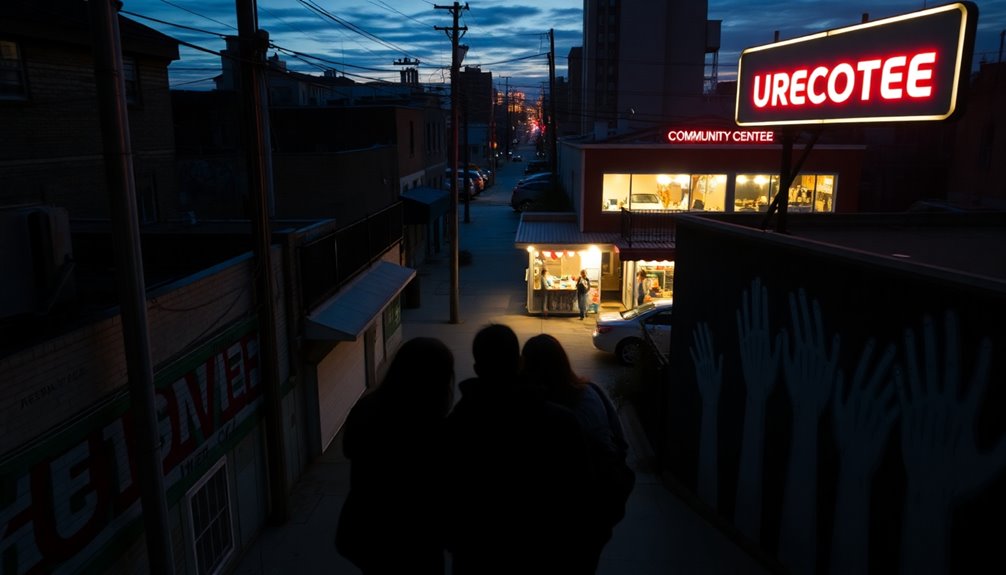
If you're looking to make a difference in the fight against sex trafficking, there are numerous ways to get involved and support survivors.
You can start by volunteering with local organizations like HAWC, which provides essential services to empower victims on their recovery journey.
Additionally, consider donating to verified anti-trafficking organizations that fund critical support programs, such as legal aid and mental health care.
Advocate for policy changes by reaching out to local legislators, urging them to strengthen laws and funding for anti-trafficking initiatives.
Finally, participate in awareness campaigns and community events to educate others about trafficking signs and prevention.
Completing training programs like Human Trafficking 101 can also equip you with valuable knowledge to contribute effectively to advocacy efforts.
Future Prevention Strategies
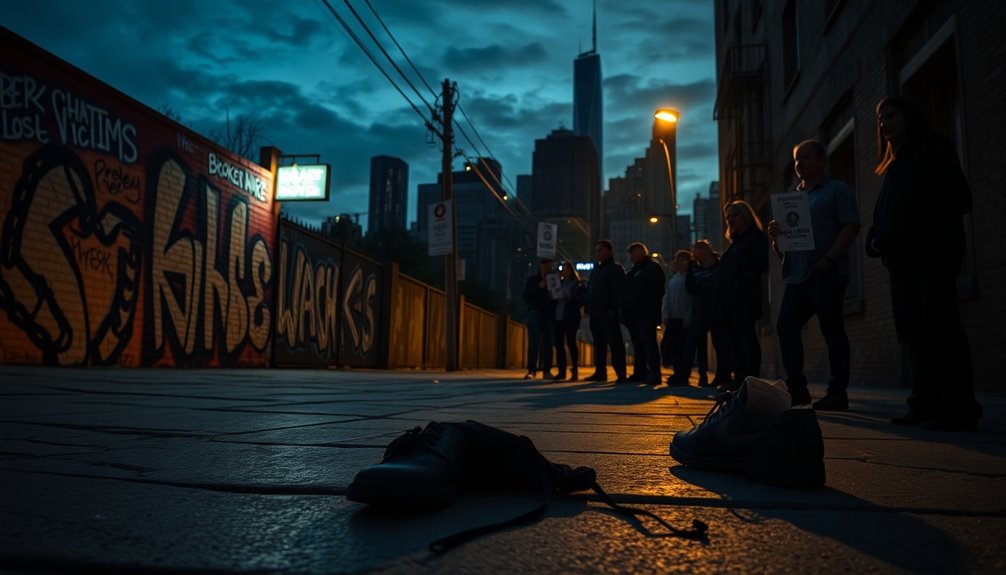
While many communities grapple with the harsh reality of sex trafficking, there are proactive strategies that can be implemented to prevent its occurrence.
Focus on community education and awareness campaigns in trafficking hotspots to inform individuals about the signs and risks involved. Strengthening local law enforcement training ensures a swift response to trafficking cases, providing critical support for victims.
Additionally, implementing comprehensive victim support services, including mental health care and job training, aids survivors in their recovery and reduces the risk of re-trafficking. Forming partnerships between government agencies, non-profits, and community organizations enhances outreach efforts.
Lastly, advocate for stricter penalties for traffickers and increased funding for anti-trafficking initiatives to deter criminal activities and build community resilience.
Frequently Asked Questions
What Are the Common Signs of Someone Being Trafficked?
When you're trying to identify signs of someone being trafficked, look for unusual behavior.
They might seem fearful, withdrawn, or overly submissive. You might notice they're not allowed to speak for themselves or have a lack of personal possessions.
If they appear disconnected from family and friends, that's a red flag.
Pay attention to any signs of physical abuse or malnourishment as well.
Trust your instincts; if something feels off, it probably is.
How Can I Report Suspected Sex Trafficking in My Area?
If you suspect sex trafficking in your area, it's crucial to act.
You can report your concerns to local law enforcement or call the National Human Trafficking Hotline at 1-888-373-7888.
Provide as much information as possible, like descriptions of individuals or suspicious activities.
Remember, your report can make a difference, so don't hesitate to speak up.
You might help someone escape a dangerous situation and get the support they need.
Are There Specific Demographics More at Risk for Trafficking?
Yes, certain demographics are more at risk for trafficking.
Vulnerable populations, such as runaways, homeless youth, and individuals from low-income backgrounds, often face higher risks. Those with a history of abuse or neglect may also be targeted.
Additionally, marginalized communities, including immigrants and people of color, can be more susceptible due to economic instability and lack of resources.
It's vital to stay informed and support initiatives that protect these at-risk groups.
What Legal Protections Exist for Trafficking Victims?
There are several legal protections in place for trafficking victims. You can benefit from laws that allow you to seek restitution and support services.
The Trafficking Victims Protection Act (TVPA) provides crucial protections, ensuring you have access to housing, healthcare, and legal assistance.
Many states also have specific laws aimed at aiding victims, allowing you to report crimes without fear of legal repercussions.
These measures help empower you to reclaim your life and seek justice.
How Does Technology Facilitate Sex Trafficking Today?
Technology's become a powerful tool in facilitating sex trafficking today.
You'll notice that traffickers use social media and online platforms to recruit and exploit victims, often masking their true intentions. They create fake profiles, luring individuals with false promises.
Additionally, encrypted messaging apps help them communicate discreetly, evading law enforcement.
Online marketplaces also enable the sale of services, making it easier for traffickers to operate under the radar while targeting vulnerable individuals.
Conclusion
In conclusion, understanding the harsh realities of sex trafficking can empower you to make a difference. By staying informed about the worst cities and their contributing factors, you can help shine a light on this issue. Engage with community initiatives, support resources for victims, and advocate for effective prevention strategies. Together, we can work towards a future where every individual is safe and free from exploitation. Your awareness and action are crucial in the fight against sex trafficking.










